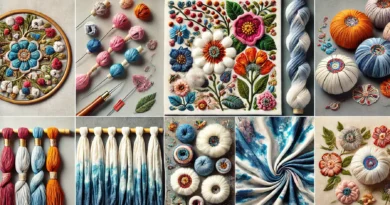The Future of Handicrafts: 7 Innovative Materials That Are Revolutionizing Handmade Art
Handicrafts have always been an authentic expression of human creativity, passing down stories and traditions from generation to generation. However, with technological advancements and the pursuit of sustainability, new innovative materials are emerging to transform this ancient art. These materials not only expand creative possibilities but also promote environmentally responsible solutions.
The fusion of tradition and innovation paves the way for a future of handicrafts filled with sustainable, durable, and surprising alternatives. Artists and artisans have been exploring these materials to create pieces that push the boundaries of imagination while preserving the human touch that makes handmade work so special.
Whether in jewelry making, decorative objects, or clothing, the inclusion of innovative materials not only revolutionizes design but also contributes to a more balanced planet. Below, discover seven of these materials that are transforming the way we see handicrafts.
1. Bioplastic
Bioplastic is an eco-friendly alternative to conventional plastics, derived from renewable sources such as cornstarch, sugarcane, and algae. Unlike traditional plastic, it is biodegradable and can be molded into various shapes, making it perfect for jewelry, artisanal packaging, and decorative utensils.
2. Pineapple Fabric (Piñatex)
Made from pineapple leaf fibers, Piñatex has gained traction in sustainable fashion and artisanal design. It is a vegan alternative to leather, offering durability and a sophisticated look. Artisans have been using this material to create bags, wallets, and even clothing.
3. Transparent Wood
Yes, wood can be transparent! This innovative material undergoes a chemical treatment that removes its lignin, making it translucent. With it, artisans can create lamps, furniture, and decorative objects that blend the natural beauty of wood with the modernity of glass.
4. Smart Clay
Smart clay is a flexible and durable material that hardens only when exposed to heat. This allows artisans to adjust their creations before the final finishing, reducing waste. It is widely used for sculptures, jewelry, and personalized utensils.
5. BioGlass
BioGlass is made from recycled glass, combining sustainability and sophistication. Its production reduces environmental impact and enables the creation of unique pieces, such as glasses, plates, and decorative ornaments.
6. Mushroom Leather (Mylo)
Mushroom leather, also known as Mylo, is a flexible and durable material created from mycelium, the underground structure of fungi. It is already used by major fashion brands and has great potential for artisanal applications such as wallets, belts, and decorations.
7. Seed Paper
A fantastic solution for the future of handicrafts, seed paper can be planted after use. It contains seeds embedded in its fibers, allowing it to sprout flowers, herbs, or vegetables. Artisans have used this innovation to create invitations, tags, and eco-friendly packaging.
How to Apply These Materials to Your Handicrafts
If you want to experiment with these innovative materials, you can start with small projects. For example, to test seed paper, try creating eco-friendly business cards. If you want to innovate in fashion, Piñatex is a great option for handmade wallets.
The future of handicrafts is increasingly aligned with sustainable and technological demands. With these new innovative materials, artisans can explore unlimited possibilities, creating pieces that combine beauty, environmental awareness, and boundless creativity. Whatever your niche, this revolution is within your reach!



